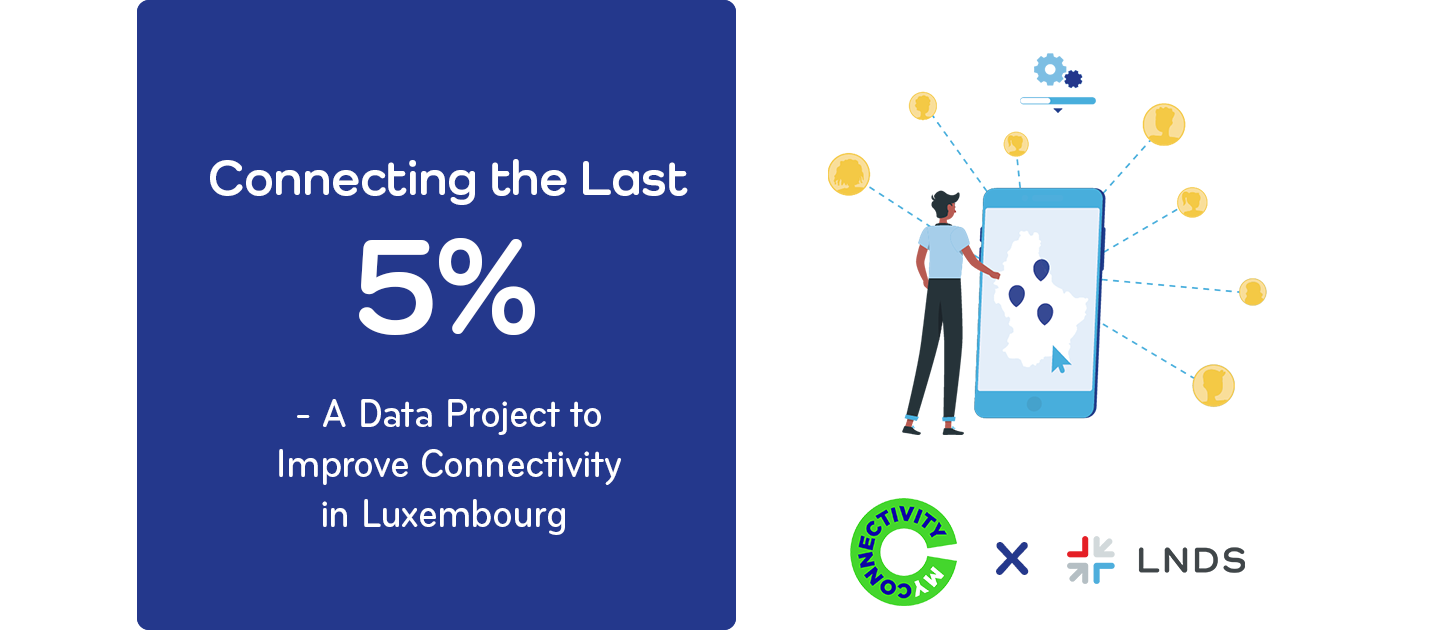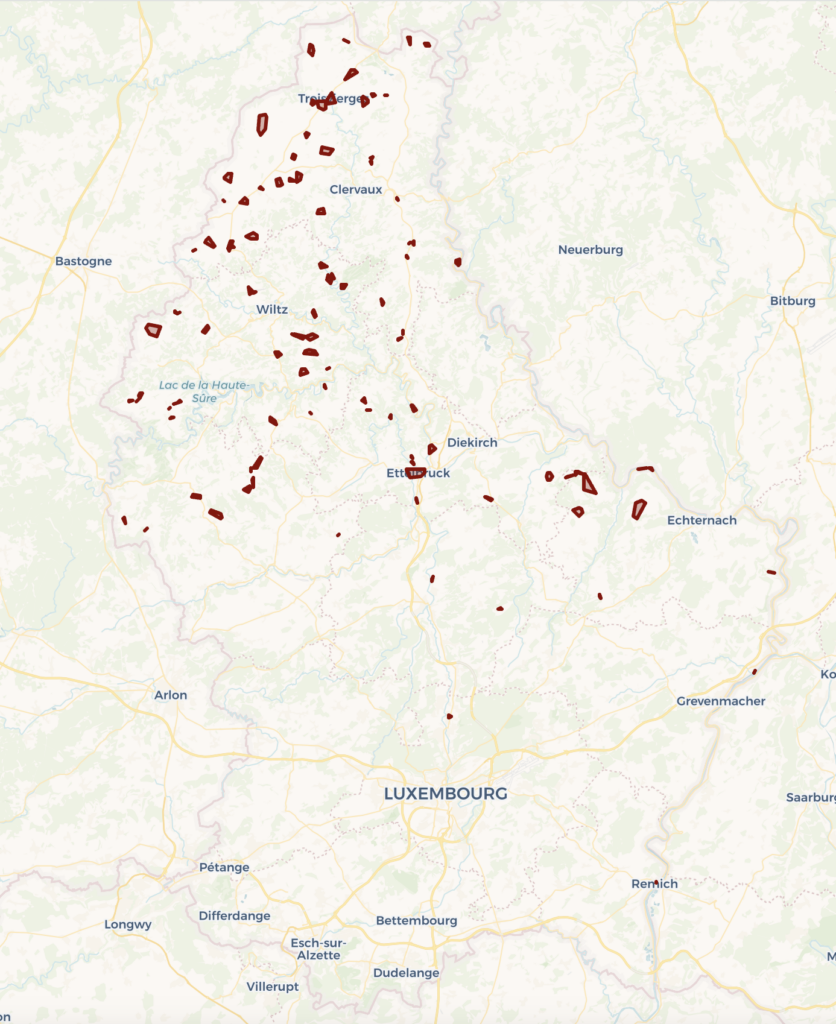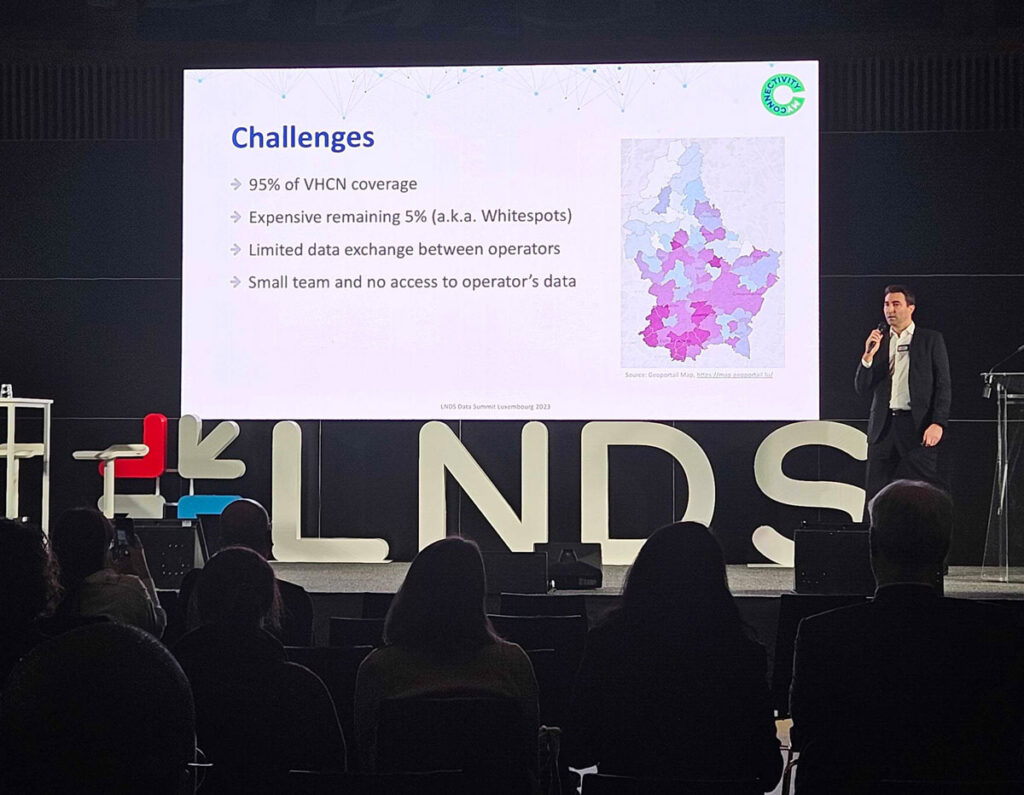
The last 5%: Identifying and quantifying the gap to improve connectivity in Luxembourg
5% may seem a negligible number, but even such a small number can have a significant impact. 5% represents the remaining population in Luxembourg without access to a future-proof internet connection. This is not just a number; it is a barrier to inclusion, progress, and equal opportunity. In July 2023, LNDS (Luxembourg National Data Service) and MyConnectivity teamed up to objectively analyse these gaps with the aim to fill the gap and improve connectivity for all in Luxembourg.
5% of buildings in Luxembourg lack future proof internet connection
In Luxembourg, 99,4% of the population use internet (Statec, 2023). The same report shows that the average for European Union (EU) is 91%. With such a vast number of the population using internet, the fact that 5% of the country’s buildings still lacks ultra-high-speed connectivity can have strong negative impact on the society of people living and working in Luxembourg.
There is an ongoing effort in Luxembourg to achieve the objectives of the EU by improving and expanding the ultra-high-speed broadband in the country. While 95% of the country is covered by terrestrial VHCN (Very High Capacity fixed Networks), the remaining 5% are expensive to close. For this remaining 5% with currently no ultra-high-speed broadband availability, a prioritisation of areas and a strategy is needed to monitor and support the investments in an improved internet connection.
Glossary of Key definitions:
Contributing to improve high-speed connectivity throughout the Grand Duchy of Luxembourg – Creation of a data project
A data project is a defined project between LNDS and a partner organisation, who has a need to use Luxembourgish public sector data to solve a societal problem or gap. MyConnectivity is a Joint Economic Interest Group (G.I.E) comprising actors from both the public and private sectors. The core mission of MyConnectivity is to enhance the availability and utilisation of ultra-high-speed connectivity throughout in the Grand Duchy of Luxembourg.
To reach their goal, MyConnectivity faced the challenge of limited data exchange between operators and no access to the necessary datasets from the operators. With this challenge, MyConnectivity approached LNDS to start a data project. The project was initiated as a part of an ongoing effort to document ultra-high-speed broadband availability in the Grand Duchy of Luxembourg. LNDS and MyConnectivity joined forces to co-develop a ‘connectivity detector’ based on the data from the Institut Luxembourgeois de Régulation (ILR).
This venture is not just about connectivity; it’s about fostering tailored solutions for rural areas and ensuring an interconnected future for everyone.
Julien Larios, Technical Director at MyConnectivity G.I.E.
The data project with MyConnectivity addresses the 5% gap in areas lacking ultra-high-speed broadband connectivity. At first glance, 5% may seem negligible, a mere fraction. However, based on the dataset from the ILR, we can see that 5% of the buildings in Luxembourg equals to around 8,000 buildings. In the case of connectivity and internet, it means that the population living in these 8,000 buildings, do currently not have access to a future-proof internet connection. This is set to change in the future.
Utilising Data Services to understand the landscape and detect missing ultra-high-speed connection points
The co-developed data project between LNDS and MyConnectivity is a pilot project to understand the landscape of Luxembourg and detect the missing ultra-high-speed connection points. The project is based on knowledge sharing between the two parties, and leveraging the data services of LNDS. The utilised services include the first delivery of the Data Extraction, Enrichment and Merging service, a proof-of-concept for our Secure Processing Environment, and the application of our Data Analysis and Visualisation Support service, currently under development. In addition to the setup of adequate tooling and data pipelines for data extraction, enrichment, and merging, we also supported MyConnectivity with providing expert advice on ELSI subjects, in order to detect and describe missing ultra-high-speed connection points in Luxembourg.
How did the data project look like in practice?
Like all data projects, the first step to start was an onboarding meeting, in order to map the scope of the project. Within this step, we together define what data will be needed, and which of our services can support in fulfilling the aim of the project.
Over eight months of collaboration and co-creation, from July 2023 to February 2024, the project consisted of a workshop to define the analysis methodology, legal support regarding the non-disclosure agreement (NDA) between MyConnectivity and the Institut Luxembourgeois de Régulation (ILR) that led to the provision of the necessary dataset and upload into our Secure Processing Environment. After data provision was successfully completed, all available datasets were merged, enriched, and processed, followed by a downstream clustering analysis to detect potential missing ultra-high-speed connection points.
Data provision from project partners
To fulfil the project goal, we have established a collaboration between the stakeholders of the project, with the necessary legal basis and agreements in place. In this project, the partners include the ILR, MyConnectivity, and LNDS. We co-developed an actionable base of workflows, processes, and data pipelines to first collect data and provide it to the processing environment (data extraction). In the next step, we enriched and merged the data that was provided from the ILR. Finally, we analysed the data and applied reasonable methods (e.g. clustering approaches) to identify and quantify the areas missing ultra-high-speed connection points.
Impact & results from the data project
This pilot project demonstrates an end-to-end data processing pipeline from solving legal blockers, data provision, processing and subsequent analysis using multiple LNDS’ services. It also highlights some of the challenges involved, in particular with regards to legal blockers and proper orchestration or interaction between the LNDS’ services. Using the data services we co-developed an interactive map based on public data to enable stakeholders, such as local telecom companies, to prioritise and target investments effectively.

Impact on society of improved connectivity
From a societal perspective, ultra high-speed broadband has numerous benefits of people’s daily life in Luxembourg. Ensuring ultra-high-speed connectivity supports accessibility and equal opportunities and is especially important for people who are limited by mobility. To understand the priorities and challenges related to connectivity and internet for people living and working in Luxembourg, we used the concept of personas. The personas are a way to build fictional characters of a population, representing its various needs and challenges. Based on this study, we could find out that the benefits of improving connectivity include but are not limited to enabling:
- Access to telemedicine and medical care: Real-time video streaming is required to make online consultations and to give medical advice. Medical images could also be shared between doctors and patients in these sessions. The same applies also for remote assistance on other fronts, such as technical support or maintenance.
- Remote work and teleconferencing: Working from home and participating in virtual meetings, collaborating on large files and accessing company resources with none or minimal delays requires a stable connection, in particular for meetings with many participants. This is also the case for anyone taking online courses, video lectures or any other e-learning platforms, to avoid disruptions during learning.
- Big Data Analysis: Handling and analysing large datasets require a high-speed connection for processing and analysis tasks. Generally, working in the data analytics, simulations and research fields benefit from an excellent internet connection.
- Social interaction, entertainment and online purchases: From video calls with family and friends, online games, or social media – all of these services need a reliable internet connection. The same applies for high-quality video streaming as well as online shopping for anything from medication, clothes, to buying tickets for concerts, where a high-speed internet is essential to access tickets to popular concerts.
- Future technologies: Technology evolves constantly and new innovations like smart homes, cities and autonomous vehicles will need ultra-high-speed internet to operate seamlessly.
Impact from a technology perspective
The development of this processing pipeline represents an essential milestone both for this pilot project and its successors. Through analysing and working with the data, we could together build an interactive and user-friendly map, which MyConnectivity can use in their further projects for analysing and developing solutions for connectivity in Luxembourg. The map is divided in layers, to enable easy understanding and possibility for MyConnectivity to showcase the ongoing work to Ministries, amongst others.
Showcasing results of the project
The project was first time showcased to the public during the Data Summit Luxembourg, by Julien Larios, Technical Director at MyConnectivity. As described by Julien, the project, leveraging the “Relevé Géographique de Déploiement des Réseaux” as published on Geoportail by the ILR and incorporating socio-demographic data, benefitted from LNDS’s data science proficiency to identify and analyse areas missing ultra-high-speed connectivity.

The impact of the project is about more than simply connectivity. It is about the societal impact of enabling a future where everyone has the same opportunity to stay connected. This can only be done if urban and rural areas alike are addressed with tailored solutions.
“The results of the pilot project are impressive. The structured and supportive working methodology of LNDS leads to constructive planning of target-oriented initiatives already today.”
Viktor Dick, Head of Projects at MyConnectivity G.I.E.
Not only will the project enable better connectivity for the people in Luxembourg, but it has also shown a short-term impact on supporting MyConnectivity in showcasing their results. Amongst others, MyConnectivity presented the map to the Minister Delegate to the Prime Minister, responsible for Media and Connectivity, Elisabeth Margue, during her visit at MyConnectivity’s premises. The interactive map assisted MyConnectivity in properly presenting their objectives, this project, and other initiatives in the area of connectivity to external audiences. Thanks to the interactive visualisation, their results and objectives were better understood.
Collaboration continues in three new data projects
It turned out that this data project came to be the first of many. To follow up on the fruitful collaboration, LNDS and MyConnectivity have already defined three new data projects to further continue the work to improve connectivity in Luxembourg. The projects will utilise and further co-develop the service portfolio of LNDS, focusing on amongst other Data Access Request and Review, Data Visualisation service (in development), Data Enrichment service, and Secure Processing Environment (in development).
We are very much looking forward to continuing this collaboration to achieve tangible results for connectivity for everyone living and working in Luxembourg.
Quoting MyConnectivity (LinkedIn, 2023): “Keep an eye out for more updates as we embark on a journey towards a more connected Luxembourg.”
How to get started with a data project?
Do you have a project in mind where you would need support to use or access public sector data? Fill in the onboarding form to start a potential data project.


